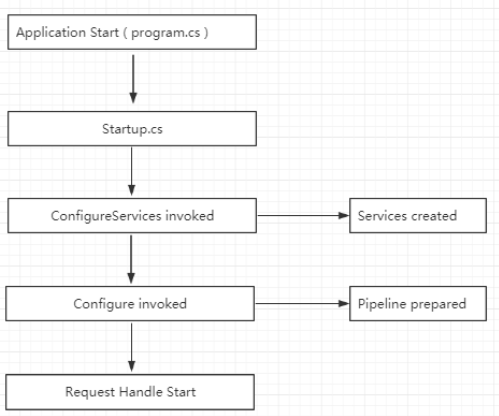学无止境,精益求精
十年河东,十年河西,莫欺少年穷
学历代表你的过去,能力代表你的现在,学习代表你的将来
在探讨Startup启动类之前,我们先来了解下Asp.NET CORE 配置应用程序的执行顺序,如下图所示

与早期版本的 ASP.NET 对比,最显著的变化之一就是配置应用程序的方式, Global.asax、FilterConfig.cs 和 RouteConfig.cs 统统消失了,取而代之的是 Program.cs 和 Startup.cs。Program.cs 作为 Web 应用程序的默认入口,不做任何修改的情况下,会调用同目录下 Startup.cs 中的 ConfigureServices 方法 和 Configure 方法。
首先我们来看下Progarm.cs,如下

public class Program { public static void Main(string[] args) { CreateWebHostBuilder(args).Build().Run(); } public static IWebHostBuilder CreateWebHostBuilder(string[] args) => WebHost.CreateDefaultBuilder(args) .UseStartup<Startup>(); }
我们看到Program中Main函数很像我们之前的Console应用程序,那么它当中的CreateWebHostBuilder究竟做了什么事情呢?既然.Net Core是开源的,我们看源码就方便了很多,接下来就从源码来了解下它究竟做了什么工作。

/// <summary> /// Initializes a new instance of the <see cref="WebHostBuilder"/> class with pre-configured defaults. /// </summary> /// <remarks> /// The following defaults are applied to the returned <see cref="WebHostBuilder"/>: /// use Kestrel as the web server and configure it using the application's configuration providers, /// set the <see cref="IHostingEnvironment.ContentRootPath"/> to the result of <see cref="Directory.GetCurrentDirectory()"/>, /// load <see cref="IConfiguration"/> from 'appsettings.json' and 'appsettings.[<see cref="IHostingEnvironment.EnvironmentName"/>].json', /// load <see cref="IConfiguration"/> from User Secrets when <see cref="IHostingEnvironment.EnvironmentName"/> is 'Development' using the entry assembly, /// load <see cref="IConfiguration"/> from environment variables, /// load <see cref="IConfiguration"/> from supplied command line args, /// configure the <see cref="ILoggerFactory"/> to log to the console and debug output, /// and enable IIS integration. /// </remarks> /// <param name="args">The command line args.</param> /// <returns>The initialized <see cref="IWebHostBuilder"/>.</returns> public static IWebHostBuilder CreateDefaultBuilder(string[] args) { var builder = new WebHostBuilder(); if (string.IsNullOrEmpty(builder.GetSetting(WebHostDefaults.ContentRootKey))) { builder.UseContentRoot(Directory.GetCurrentDirectory()); } if (args != null) { builder.UseConfiguration(new ConfigurationBuilder().AddCommandLine(args).Build()); } builder.ConfigureAppConfiguration((hostingContext, config) => { var env = hostingContext.HostingEnvironment; config.AddJsonFile("appsettings.json", optional: true, reloadOnChange: true) .AddJsonFile($"appsettings.{env.EnvironmentName}.json", optional: true, reloadOnChange: true); if (env.IsDevelopment()) { var appAssembly = Assembly.Load(new AssemblyName(env.ApplicationName)); if (appAssembly != null) { config.AddUserSecrets(appAssembly, optional: true); } } config.AddEnvironmentVariables(); if (args != null) { config.AddCommandLine(args); } }) .ConfigureLogging((hostingContext, logging) => { logging.AddConfiguration(hostingContext.Configuration.GetSection("Logging")); logging.AddConsole(); logging.AddDebug(); logging.AddEventSourceLogger(); }). UseDefaultServiceProvider((context, options) => { options.ValidateScopes = context.HostingEnvironment.IsDevelopment(); }); ConfigureWebDefaults(builder); return builder; }

internal static void ConfigureWebDefaults(IWebHostBuilder builder) { builder.UseKestrel((builderContext, options) => { options.Configure(builderContext.Configuration.GetSection("Kestrel")); }) .ConfigureServices((hostingContext, services) => { // Fallback services.PostConfigure<HostFilteringOptions>(options => { if (options.AllowedHosts == null || options.AllowedHosts.Count == 0) { // "AllowedHosts": "localhost;127.0.0.1;[::1]" var hosts = hostingContext.Configuration["AllowedHosts"]?.Split(new[] { ';' }, StringSplitOptions.RemoveEmptyEntries); // Fall back to "*" to disable. options.AllowedHosts = (hosts?.Length > 0 ? hosts : new[] { "*" }); } }); // Change notification services.AddSingleton<IOptionsChangeTokenSource<HostFilteringOptions>>( new ConfigurationChangeTokenSource<HostFilteringOptions>(hostingContext.Configuration)); services.AddTransient<IStartupFilter, HostFilteringStartupFilter>(); services.AddRouting(); }) .UseIIS() .UseIISIntegration(); }
从源码中我们可以看到,CreateDefaultBuilder执行的任务有:
1、加载主机和应用程序的配置表信息
2、配置日志记录
3、设置Web服务器
4、设置Asp.Net Core应用程序的托管形式。
Asp.Net Core应用程序的托管形式,它有两种托管形式:进程内托管InProcess和进程外托管OutOfProcess。我们知道Asp.Net Core是可以自托管的,它默认托管形式就是InProcess。那么这两种方式的区别是什么呢?
InProcess:配置进程内托管在项目.csproj文件中 <AspNetCoreHostingModel>InProcess</AspNetCoreHostingModel>,在InProcess托管情况下,CreateDefaultBuilder()方法调用UseIIS()方法并在IIS工作进程(w3wp.exe或iisexpress.exe)内托管应用程序,从性能角度,InProcess托管比OutOfProcess托管提供了更高的请求吞吐量。
OutOfProcess:有2个Web服务器-内部Web服务器和外部Web服务器,内部Web服务器是Kestrel,托管进程是dotnet.exe;外部web服务器可以是iis,nginx,apache。
总之,我们可以初步理解为Program.cs 主要用来构造,配置,并启用项目所依赖的服务器,最后设置Asp.Net Core应用程序的托管形式。
在Program.cs中,我们发现它会引用Startup.CS,如下:
public static IWebHostBuilder CreateWebHostBuilder(string[] args) => WebHost.CreateDefaultBuilder(args) .UseStartup<Startup>();
下面我们来看看启动类Startup.CS,如下:

public class Startup { public Startup(IConfiguration configuration) { Configuration = configuration; } public IConfiguration Configuration { get; } // This method gets called by the runtime. Use this method to add services to the container. public void ConfigureServices(IServiceCollection services) { services.Configure<CookiePolicyOptions>(options => { // This lambda determines whether user consent for non-essential cookies is needed for a given request. options.CheckConsentNeeded = context => true; options.MinimumSameSitePolicy = SameSiteMode.None; }); services.AddMvc().SetCompatibilityVersion(CompatibilityVersion.Version_2_1); } // This method gets called by the runtime. Use this method to configure the HTTP request pipeline. public void Configure(IApplicationBuilder app, IHostingEnvironment env) { if (env.IsDevelopment()) { //如果是开发环境,允许抛出异常 app.UseDeveloperExceptionPage(); } else { //生产环境,直接错误页 app.UseExceptionHandler("/Error"); app.UseHsts(); } app.UseHttpsRedirection(); app.UseStaticFiles(); app.UseCookiePolicy(); app.UseMvc(); } }
Startup 类的作用:
1. ConfigureServices方法用于定义(注册)应用程序所使用的服务。(如:ASP.NET Core MVC,Entity Framework Core,Identity 等);
2. Configure方法用于定义请求管道的中间件,该管道将用于处理应用程序的所有请求。
3. 注册服务添加方法是无序的,ASP.NET Core在应用程序启动的时候,只要有相应服务即可,而注册中间件时方法是有序的,管道内的每一个组件都可以选择是否将请求交给下一个组件,并在管道中调用下一个组件之前或之后执行某些操作。
1. ConfigureServices
应用通过 ConfigureServices 添加服务。 然后,主机和应用服务都可以在 Configure 和整个应用中使用。
也就是说在 ConfigureServices 中,我们...
在NETCORE中,依赖注入几乎无处不在,
未完,待续...下班了,中元节,不该过多加班的。
